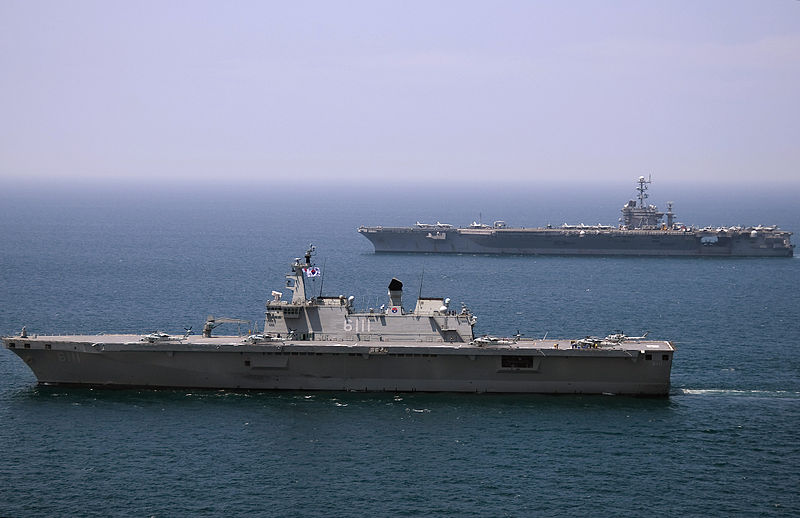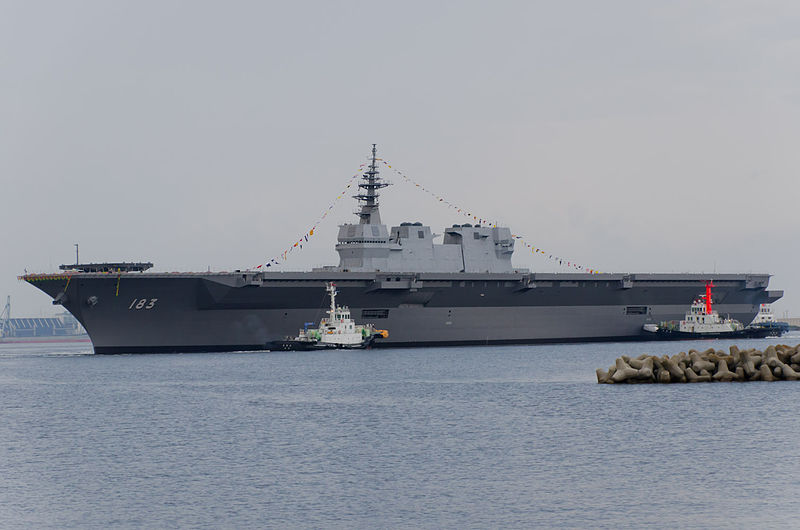Last week, Strategy Page considered the options available for both South Korea and Japan to convert some of their F-35 orders to F-35B variants which would allow operations from small helicopter carriers in service or in plan for both navies:

The Republic of Korea Navy amphibious landing ship ROKS Dokdo (LPH 6111) and the aircraft carrier USS George Washington (CVN 73) transit the Sea of Japan (July 27, 2010).
U.S. Navy photo by Mass Communication Specialist 3rd Class Charles Oki via Wikimedia Commons.
In October South Korea announced it was buying 20 more F-35 stealth fighters. There are already 40 on order and South Korea will have received 13 by the end of 2019. Those 60 F-35s will cost $9.7 billion and a decision still has to be made as to whether any of the second 20 will be the VTOL (Vertical Take-Off and Landing) F-35B version. The first 40 will all be the basic F-35A which just operates from land-based airfields. But South Korea has ships that F-35Bs could operate from.
By 2018 South Korea had two 14,500 ton Dokdo class large amphibious ships. These South Korea LPHs (Landing Platform Helicopter) are similar in appearance and operation to the larger American amphibious ships. The LPH flight deck can handle helicopters, as well as vertical takeoff jets like the F-35B. The Koreans deny that the ship will be used with these jets, but the capability is there. The LPH normally carries 720 combat troops and their heavy equipment. Dokdos also carry fifteen aircraft; two V-22 vertical takeoff transports and 13 helicopters. Marado, the second Dokdo, has a redesigned flight deck that can handle two V-22s at once instead of just one. In addition to a more powerful 3-D surveillance radar for tracking aircraft, Marado has to Phalanx anti-missile system.
South Korea is also planning to build one or more 30,000 ton ships that look like the Japanese DDH (destroyer helicopter carrier) and could handle a dozen F-35Bs. Neighboring Japan has already ordered some F-35Bs so that it can experiment with some of these aircraft aboard the existing Japanese DDHs. Since 2017 Japan has had two 27,000 ton “destroyers” (DDH type ships) that look exactly like an aircraft carrier. These Izumo class ships can carry up to 28 helicopters or up to ten vertical takeoff aircraft. The carriers are armed only with two 20mm Phalanx anti-missile cannon and launchers with sixteen ESSM missiles for anti-missile defense. The DDH have powerful engines capable of destroyer-like speeds of over fifty-four kilometers an hour. Izumo has considerable cargo capacity, which is intended for moving disaster relief supplies quickly to where they are needed. Apparently, some of these cargo spaces can be converted to carry additional weapons and equipment needed to support F-35B fighter-bombers. Izumo could carry and operate at least ten F-35Bs once modifications are made to the flight deck to deal with the extremely high temperatures the F-35B generates when taking off or landing vertically (like a helicopter). When the first DDH entered service in 2015 Japan made no mention of buying F-35Bs or modifying the LPH flight decks to handle the very high temperatures. The Izumos already have an elevator (to the hanger deck under the flight deck) powerful enough to carry an F-35B fighter.
Another factor that makes operating F-35Bs from an LPH or DDH possible is the availability of smart bombs and small air-to-ground guided missiles for warplanes. A LPH or DDH was not designed to haul a lot of munitions for aircraft but, the amount of smart bombs and missiles needed to make five or ten F-35Bs effective would not be large. These ships already carry a lot of fuel for helicopters and have space for maintenance gear to support many helicopters. South Korean and Japanese naval planners noted this when they suggested using LPHs and DDHs as platforms for F-35Bs.




